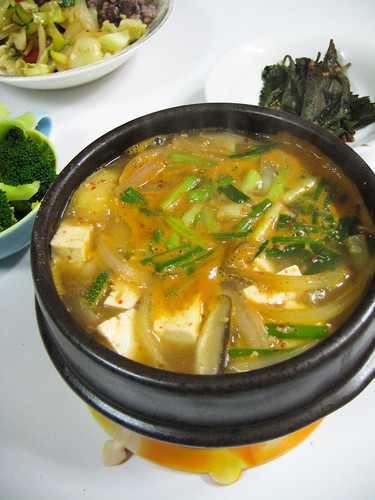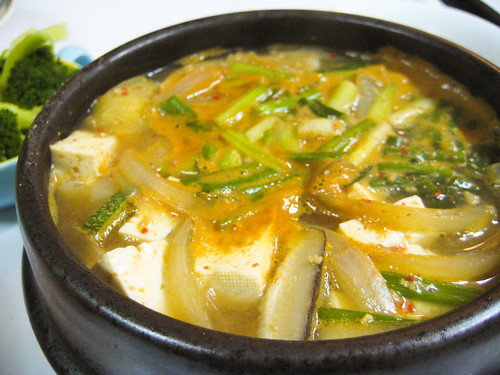One of the harder things about being vegan here is that many of the dishes in Korean restaurants are made with fish-flavored stock. I love all jjigae's (Korean soups), from dwenjang, soondoobu, to kimchi jjigae, but unfortunately, I never order them at restaurants because I know that the stock has been flavored with shriveled up anchovies (not to mention the typical addition of clams, shrimp, or eggs). Many Koreans say that the flavor of the soup lies in the boiling of these unfortunate creatures, but I find that it's entirely possible to make equally flavorful and soul-satisfying soups without.

These days, I'm in the process of slowly expanding and improving my Korean cooking skills. I still have a long ways to go, but I'm happy to announce that I'm now comfortable enough with making my own dwenjang jjigae to talk about it on my blog. And it's pretty darn tasty, if I may say so myself. Actually, making delicious vegan dwenjang jjigae is so easy. Also, based on what vegetables you have, your dwenjang jjigye can be a little different every time!
{ Ingredients & estimated measurements }
1-2 strips of dried kelp (dashima)
1/4 onion, cut into chunks or strips
a few shiitake mushrooms, sliced
2-3 cups of water
1/2 cup chopped zucchini
1/3 block of tofu
2 Tbs of dwenjang (fermented soybean paste)
1/2 - 1 tsp red chili pepper flakes
handful of chopped green onions
{ Method }
First up, you gotta make your soup stock. Some efficient folk like to boil a large batch of stock and keep it on-hand in the fridge for spontaneous jjigae-making, but it's also no problem to just make some on the spot, which is what I do. For my stock, I add a strip of dried dashima (kelp), the diced onions, shiitake mushrooms, and just boil it all in some water (maybe 2-3 cups?). You can also add a chunk of radish if you so desire. Then, once it's been boiling for a few minutes, take out the dashima, and begin adding your other ingredients.

I like to keep things pretty simple with just some zucchini and tofu. Feel free to add other veggies like potatoes, chili peppers, or paengi mushrooms (팽이버섯). Next, dissolve the dwenjang in the soup. If you want it a little spicy, you can add some red pepper flakes, or even some chopped green or red chili peppers. Finally, once all the other ingredients are cooked through, throw in some green onions and cook just til they're soft. Serve and enjoy!